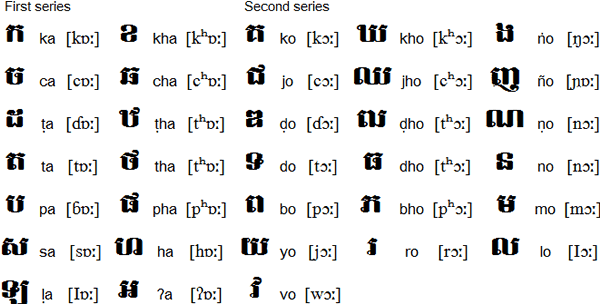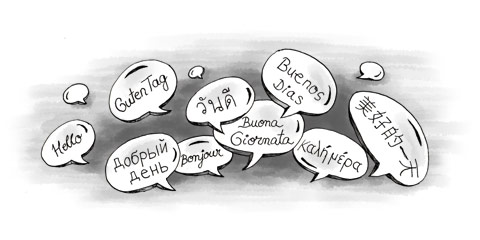Khmer
The official language of Cambodia is Khmer. It originates from the Khmer people and has been influenced considerably by Sanskrit and Pali, particularly in the royal and religious registers, and through Hinduism and Buddhism. The language has come in close contact with Thai, Lao, Vietnamese and Cham due to geographical proximity and cultural connection. Khmer’s main distinction from its neighbouring languages is that it is not a tonal language.
The earliest written and recorded language from the Mon-Khmer family, Khmer is spoken by 90% of the population (some 7 million people) and is used in most social and professional contexts such as government administration, education at all levels and in mass media. After Vietnamese, it is the second most widely spoken Austroasiatic language.
Modern Khmer is used nationwide and is understood by most of the country’s inhabitants. Influence from Sanskrit and Pali is characterised by vocabulary used in administration, and the effect of years of French colonial rule is evident in the language too.
Examples of first and second series consonants in Khmer

Khmer is mostly an analytic, isolating language. There are no conjugations, inflections or case endings. Rather, particles and auxiliary words are used to indicate grammatical relationships. General word order is subject-verb-object.
Consonants are split into two forms - a first series syllable (/a/) or a second series syllable (/o/). Vowels are written above, below, in front of, after or around consonants using separate letters or diacritics.
Below is an example of Khmer text taken from Article 1 of the Universal Declaration of Human Rights, followed by a transliteration written in the Roman alphabet and its translation into English, as a brief introduction to the language.

mnoussa teangoasa kaetamk mean seripheap ning pheap smae knea knong setthi ning sechakdeithlaithnaur. mnoussa krobroub sotthote mean vichearonanhnhean ning satesambochonhnh haey trauv br pru td champoh knea towvinhtowmk knong smartei reaban knea chea bangobaaun.
“All human beings are born free and equal in dignity and rights. They are endowed with reason and conscience and should act towards one another in a spirit of brotherhood.”
(Text taken from omniglot.com)
There is a variation of Khmer called Khmer Surin, spoken by the migrant community from Thai provinces Surin, Sisaket, Burirum and Roi Et. It differs considerably from standard Khmer with regards to vowel phonemes, lexicon, grammar and the pronunciation of syllable-final /r/.
Cambodian French
The presence of French in Cambodia began in the late 1800s when French merchants were exploring Indonesia, and Cambodia became incorporated into French Indochina in 1887. The French exerted considerably less influence on Cambodia than they did in Vietnam, and the language only began to experience some significant growth with the Japanese invasion during World War II, when French joined Cambodian as a government language. Following the war, French became the sole official language and continued to be promoted after Cambodian independence in 1953.
Since then, its levels of prominence have wavered considerably. The language began to decline heavily and when the Khmer Rouge came into power in the mid-1970s, French was almost entirely eliminated from the country. However, French was reintroduced to Cambodia by a Vietnamese invasion which established the People’s Republic of Kampuchea, and the language continued to gain ground until the current government was installed in 1993 and Cambodian became the official language.
Now English is seen as a more useful international language, but as of 1997 there is a French-language centre in the capital Phnom Penh and many Cambodian students study abroad in France every year. Moreover, French is still a diplomatic language of Cambodia and some newspapers are published in French.
French Cambodian has been influenced by Cambodian, Cantonese Chinese and Teochew Chinese, and is more distinct that standard French than the dialects of Vietnam and Laos.
Cham
Cham is not only spoken by around 200,000 people in Cambodia, but also by approximately 100,000 in Vietnam and others in Southeast Asia. It belongs to the Austronesian family. Cham had many more speakers during the time of the Champa Empire, which ruled what is now central Vietnam from around the 7th century to 1832.
Here are some example words in Cambodian Cham:
- anoek - child
- sa - one
- trap - heavy
- pasa - market
- amoh - hate
Chong
This language is endangered and is now only spoken by around 5,000 people in the Pursat province of Cambodia and by 500 in Thailand.
Jarai
The Jarai language is a Malayo-Polynesian dialect spoken by the Jarai people of Vietnam and Cambodia. The number of speakers is estimated to be around 330,000 and is in part related to the Cham language. In terms of phonology, Jarai has evolved in the pattern of the Mon-Khmer family, losing almost all vowel distinction in the first syllable.
Kuy
Although Kuy is spoken mostly in Thailand and Laos, it also features among in the Preah Vihear, Stung Treng and Kampong Thom provinces of northeastern Cambodia. A Katuic language and part of the larger Austroasiatic family, it is subject to many variations across various districts.
Stieng
This is the native language of the Stieng people of southern Vietnam and neighbouring areas of Cambodia. It too is a Mon-Khmer language from the Austroasiatic family. Bulo Stieng, its most researched dialect, is spoken mostly in the remote areas of the mountains and jungles.
The use of English
As mentioned in the description of Cambodian French earlier in the article, English is seen as the most important international language. This is largely due to Cambodia’s recent transformation towards a market economy and consequent globalisation process. Those looking to find a job easily upon graduation from university are making more of an effort to learn English so that they can deal with global investors. Those seeking jobs in tourism are also encouraged to learn English.
However, this does not mean that it is universally known or understood, and an effort should be made to integrate with the community into which you move by learning as much of the local language as possible. See our next guide article to learning the language to discover how to find language learning resources and schools in Cambodia
It is worth noting that Chinese is also emerging as a popular language in Cambodia for its practical utility.

